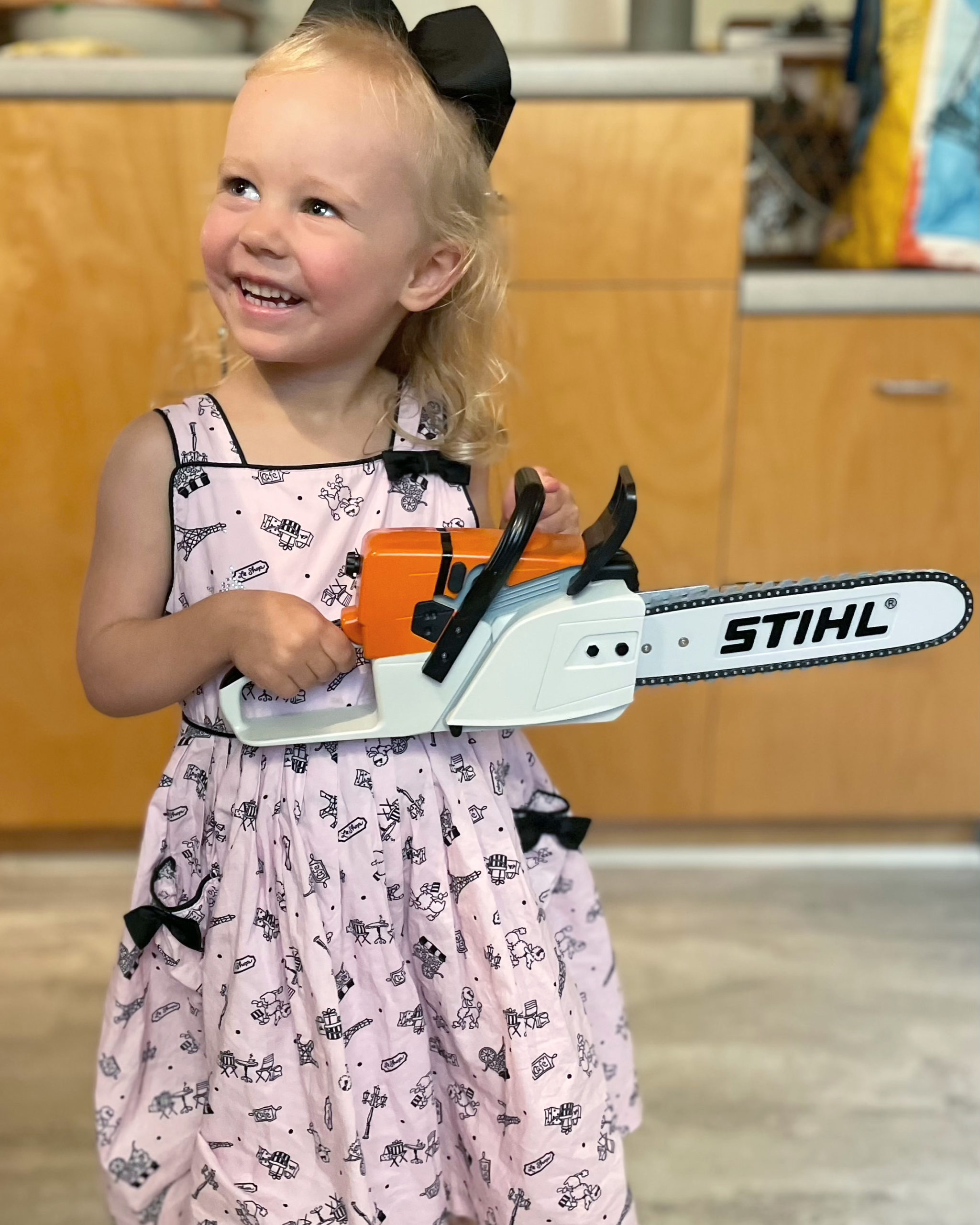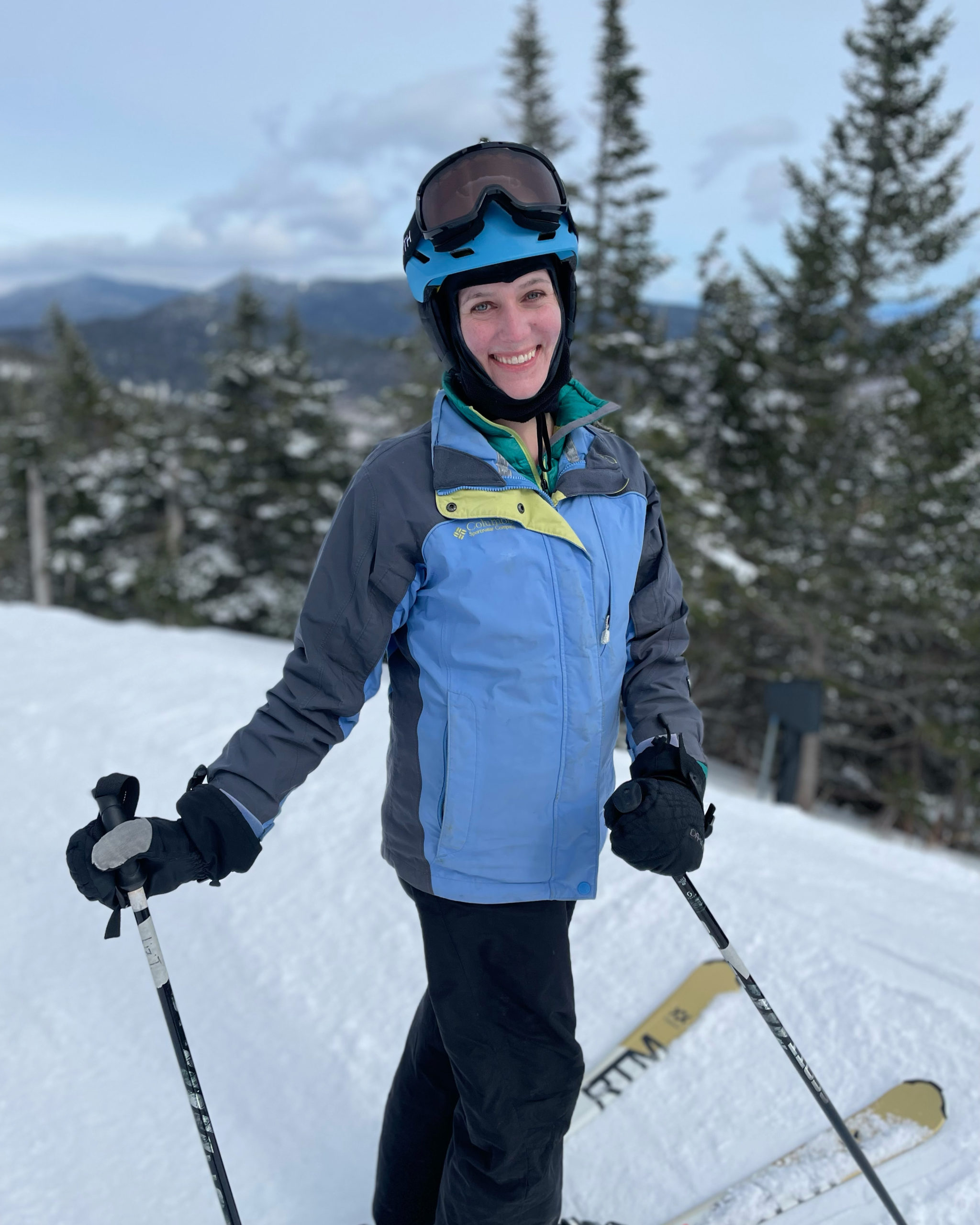After my enthusiastic foray into beginner ski lessons earlier this year, I’ve now signed up for SOMETHING EVEN MORE DANGEROUS: a beginner chainsaw safety class. I can’t say I’m excited about it, but I am looking forward to developing this skill. We live in a place where a chainsaw is a necessity and using one safely is paramount (assuming, you know, you want to retain all your limbs). We’ve gotten by these past six years with Mr. Frugalwoods as our lone chainsawer (chainsawyer?), but my time to learn has come.
Last month a giant tree fell across our driveway, which of course I didn’t discover until I was driving the kids to school in the morning. I hopped out of the truck to see if I could roll the tree off the driveway, which was a nice joke I played on myself. The thing was enormous. A chainsaw was the only option and my husband was sick in bed.
So we trudged back home and…. he had to leave his sickbed to come saw this thing out of our way. I used the log peavy to roll the bucked rounds into the woods, but he had to do the sawing himself. It really hit home for me how not-independent I am in the event of a downed tree. While I never imagined being a person who needed to take a chainsaw course, that is in fact who I am. The class is later this month and I’ll let you know how it goes. Assuming I still have fingers enough to type.
Come Hear Me Talk…. TODAY!
I’m speaking on a panel today (Friday, April 8th) at the online Mamas Talk Money: The Legacy You Leave conference at 1:30pm ET. If you’re interested in attending this three-day online conference (which you haven’t missed yet–it starts today!), you can save $5 off the $49 ticket price by using the coupon code FRUGALWOODS. Go here to get your ticket and register to attend. I hope to see you there!
Other Purchases of Note
The Dentist!
Now that we’re on the ACA, we no longer have dental insurance and are paying out-of-pocket for our dental visits. Since we anticipated this, I called all of our local dentists to find out their out-of-pocket prices for cleanings and exams and came up with some wildly divergent results. In the end, our existing dentist has one of the best prices I found and, since we’re very happy there, we decided to stay. But it was a great reminder to me to ALWAYS comparison shop. For everything. Even for things you wouldn’t think of comparison shopping for, like the dentist! Prices are not created equal.
Ok I swore I would never buy another one of these, BUT one of my BFFs bought one and had me try it out when I was at her house for lunch one day and… my life was changed. So changed, in fact, that I violated my very own 72-hour waiting period and ordered one that very day. This thing is that good. What separates this massager from massagers I’ve had in the past are the arm/hand slots. It has little pockets for your hands, which you can use to steer it around your neck and shoulders while you sit on the couch watching the Ali Wong comedy special, drinking boxed white wine. For example.
To continue my year of learning new (and moderately dangerous) things, my friends and I want to learn stand-up paddle boarding this summer. In imagining myself on top of a paddle board (which I have yet to source… ) with the sun beating down, I wanted to find a UPF-protection long-sleeved swim shirt.
I began researching and realized that most/all of these shirts do not have, ahem, chestal-region foundation garments sown into them. They’re just plain old shirts and you have to buy another bathing suit top to go underneath. This seemed like a raw deal and also like it would be uncomfortable.
Thus, I got the idea to research wet suits. Two minutes into that research, I learned that “real” wetsuits are $900. Also they have long pants, which I don’t want. Nor do I want bikini bottoms or short shorts. So then I researched faux wetsuits and came up with this one, which has everything I want:
- Long sleeves
- Made of a durable material
- Sown-in chestal-region foundation (no need to wear anything underneath it)
- UPF 50+ sun protection
- Knee-length shorts, which I appreciate for some real obvious reasons
I still feel kind of stupid wearing it because I’m (obviously) not a surfer, but I do think it’s going to really comfortable for paddle boarding and sitting in the sand with my kids. TBD. Haven’t worn it yet; there’s still snow on the ground.
I Love the Free Expense Tracker from Personal Capital!
I use a free online service called Personal Capital to keep track of our money: our spending, our net worth, our investments, our retirement–everything.
Tracking expenses is one of the best–and easiest–ways to get a handle on your finances. You absolutely, positively cannot make informed decisions about your money if you don’t know how you’re spending it or how much you have. If you’d like to know more about how Personal Capital works, check out my full write-up.
Without a holistic picture of how much you spend every month, there’s no way to set savings, debt repayment, or investment goals. It’s a must, folks. Personal Capital (which is free to use) is a great way for me to systematize our financial overviews since it links all of our accounts together and provides a comprehensive picture of our net worth.
If you’re not tracking your expenses in an organized fashion, you might consider trying Personal Capital (note: the Personal Capital links are affiliate links).
Credits Cards: How We Buy Everything
We buy everything we can with credit cards because:
-
It’s easier to track expenses. No guesswork over where a random $20 bill went; it all shows up in our monthly expense report from Personal Capital. I also spend less money because I KNOW I’m going to see every expense listed at the end of the month.
- We get rewards. Credit card rewards are a simple way to get something for nothing. Through the cards we use, we get cash back as well as hotel and airline points just for buying stuff we were going to buy anyway.
- We build our credit. Since we don’t have any debt, having several credit cards open for many years helps our credit scores. It’s a dirty myth that carrying a balance on your credit card helps your credit score–IT DOES NOT. Paying your cards off IN FULL every month and keeping them open for many years does help your score.
For more on my credit card strategy, check out:
Cash Back Cards to Consider
If you’re now cash back curious, there are a number of cards on the market right now that offer pretty good cash back percentages. Here are a few I’ve found that I think are a good deal:
1) Blue Cash Preferred ® from American Express:
- 6% cash back at U.S. supermarkets on up to $6,000 per year in purchases (then 1%).
- 6% cash back on select U.S. streaming subscriptions.
- 3% cash back at U.S. gas stations and on transit (including taxis/rideshare, parking, tolls, trains, buses and more).
- 1% cash back on other purchases.
- Earn a $300 statement credit after you spend $3,000 in purchases on your new card within the first 6 months.
- $0 fee for the first year; $95 annual fee thereafter. Rates and fees details here.
- Terms apply
2) Blue Cash Everyday ® from American Express:
- 3% cash back at U.S. supermarkets (on up to $6,000 per year in purchases, then 1%).
- 2% cash back at U.S. gas stations.
- 1% cash back on other purchases.
- Earn a $200 statement credit after you spend $2,000 in purchases on your new card within the first 6 months.
- No annual fee. Rates and fees details here.
- Terms apply.
3) Capital One Quicksilver Cash Rewards:
- 1.5% cash back on every purchase, every day.
- $200 cash bonus after you spend $500 on purchases within 3 months from account opening.
- No annual fee.
4) Capital One SavorOne Cash Rewards:
- Unlimited 3% cash back on dining, entertainment, popular streaming services and at grocery stores (excluding superstores like Walmart and Target).
- 1% back on all other purchases.
- 8% cash back on tickets at Vivid Seats through January 2023.
- $200 cash bonus after you spend $500 on purchases within the first 3 months from account opening.
- No annual fee.
- Earn an extra 1.5% on everything you buy (on up to $20,000 spent in the first year), which is worth up to $300 cash back:
- 6.5% on travel purchased through Chase Ultimate Rewards
- 4.5% on dining and drugstores
- 3% on all other purchases.
- After your first year (or $20,000 spent), you earn:
- 5% cash back on Chase travel purchased through Chase Ultimate Rewards
- 3% cash back on drugstore purchases and dining at restaurants, including takeout and eligible delivery service
- Unlimited 1.5% cash back on all other purchases.
- No annual fee.
- 5% cash back on up to $1,500 in combined purchases in bonus categories each quarter you activate.
- New 5% categories each quarter.
- 5% cash back on travel purchased through Chase Ultimate Rewards
- 3% cash back on drugstore purchases and dining at restaurants, including takeout and eligible delivery service
- Unlimited 1% cash back on all other purchases.
- $200 bonus after you spend $500 on purchases in your first 3 months from account opening.
- No annual fee.
If you’re interested in travel rewards, people love the Chase Sapphire Preferred. You can earn 60,000 bonus points after you spend $4,000 on purchases in the first 3 months from account opening, which is $750 when you redeem through Chase Ultimate Rewards.
Huge caveat to credit card usage: you MUST pay your credit card bills in full every single month, with no exceptions. If you’re concerned about your ability to do this, or think using credit cards might prompt you to spend more, stick with a debit card or cash. But if you have no problem paying that bill in full every month? I recommend you credit card away, my friend! (note: the credit card links are affiliate links).
Cash Back Earned This Month: $64.06
The silver lining to our spending is our cash back credit card. We earn 2% cash back on every purchase made with our Fidelity Rewards Visa and this month, we spent $3,203.12 on that card, which netted us $64.06.
Not a lot of money, but it’s money we earned for buying stuff we were going to buy anyway! This is why I love cash back credit card rewards–they’re the simplest way to earn something for nothing.
To see how this adds up over the course of a year, check out How I Made $712.59 With My Cash Back Credit Card.
Where’s Your Money?
Another easy way to optimize your money is to use a high-interest savings account. With these accounts, interest works in your favor as opposed to the interest rates on debt, which work against you.
Having money in a no or low interest savings account is a waste of resources–your money is just sitting there doing nothing. Don’t let your money be lazy! Make it work for you! And now, enjoy some explanatory math:
Let’s say you have $5,000 in a savings account that earns 0% interest. In a year’s time, your $5,000 will still be… $5,000.
Let’s say you instead put that $5,000 into an American Express Personal Savings account, which–as of this writing–earns 0.50% in interest. In one year, your $5,000 will have increased to $5,025. That means you earned $25 just by having your money in a high-interest account.
And you didn’t have to do anything! I’m a big fan of earning money while doing nothing. I mean, is anybody not a fan of that? Apparently so, because anyone who uses a low or no interest savings account is NOT making money while doing nothing. Don’t be that person.
Be the person who earns money while sleeping. More about high-interest savings accounts, as well as the ones I recommend, here: The Best High Interest Rate Online Savings Accounts.
Yes, We Only Paid $28.09 for Cell Phone Service (for two phones)
Our cell phone service line item is not a typ0 (although that certainly is). We really and truly only paid $28.09 for both of our phones (that’s $14.05 per person for those of you into division). How is such trickery possible?!? We use an MVNO!
What’s an MVNO?
Glad you asked because I was going to tell you anyway: It’s a cell phone service re-seller.
MVNOs are the TJ Maxx of the cell phone service world–it’s the same service, A LOT cheaper. If you’re not using an MVNO, switching to one is an easy, slam-dunk, do-it-right-away way to save money every single month of every single year forever and ever amen.
Here are a few great MVNOs to consider:
For more, I have a full chart of providers and their prices here: How to Save Money on Your Cell Phone Bill with an MVNO: I Pay $12 a Month*
*the amount we pay fluctuates every month because it’s calibrated to what we use. Imagine that! We only pay for what we use! Will wonders ever cease.
Note: these MVNO links are affiliate links.
Expense Report FAQs
- Want to know how we manage the rest of our money? Check out How We Manage Our Money: Behind The Scenes of The Frugalwoods Family Accounts
- Don’t you have a rental property? Yes! We own a rental property (also known as our first home) in Cambridge, MA, which I discuss here.
- Why do I share our expenses? To give you a sense of how we spend our money in a values-based manner. Your spending will differ from ours and there’s no “one right way” to spend and no “perfect” budget.
- Are we the most frugal frugal people on earth? Absolutely not! My hope is that by being transparent about our spending, you might gain insights into your own spending and be inspired to take proactive control of your money.
- Wondering where to start with managing your money? Take my free, 31-day Uber Frugal Month Challenge.
- If you’re interested in other things I love, check out Frugalwoods Recommends.
- Why don’t you buy everything locally? We do our best to support our local community and buy as much of our food as possible directly from our farmer neighbors. Our town doesn’t have any stores, so we rely on online ordering and big box stores for necessities. The closest stores are 45 minutes away and we go there once or twice a month to stock up on what we can’t get from our neighbors or online.
But Mrs. Frugalwoods, Don’t You Pay For X, Y, Or Even Z???
Wondering about common expenses you don’t see listed below?
- We don’t have a mortgage because we paid it off (details here)
- We pay bills in full the month we receive them. That’s why you won’t see monthly payments for things like car insurance or property tax. These expenses show up as the full annual (or bi-annual, etc) amount in the month we pay them
- Here’s what we do for health insurance.
- We don’t have any debts and we paid cash for our cars.
- Here’s how we make charitable contributions: How We Donate To Charities Like Billionaires and also How We Make Meaningful And Tax Efficient Charitable Donations.
- Here’s an overview of how we save for our kids’ higher education: How We Use 529 Plans To Save For College
- We live on 66 acres in rural Vermont, so our utilities and household expenses are different from traditional urban and suburban homes:
- We don’t pay for water, sewer, trash, or heating/cooling because we have a well, a septic system, our town doesn’t provide trash pick-up (we take it to a transfer station once a week in bags we purchase from our town), we heat our home with wood we harvest ourselves from our land, and we don’t have central air conditioning (we use window units during the hottest parts of the summer).
- There are, of course, costs associated with maintaining these systems (such as having our septic system pumped and inspected) and those expenses show up in the months we pay them.
- We have solar panels, which account for our low electricity bill.
- For more on our rural lifestyle, check out my series This Month On The Homestead as well as City vs. Country: Which Is Cheaper? The Ultimate Cost Of Living Showdown
If you’re wondering about anything else, feel free to ask in the comments section!
Alright you frugal money voyeurs, feast your eyes on every dollar we spent in March:
| Item | Amount | Notes |
| Groceries | $1,006.60 | Ummm, hard to say what happened here… we were really hungry, I guess??? YIKES |
| Preschool | $380.00 | For Littlewoods |
| Gasoline for cars | $346.12 | |
| Dentist | $237.00 | |
| Chainsaw Class for Liz | $200.00 | Fingers crossed I keep my fingers. |
| Beer, wine and alcohol | $139.27 | |
| Utilities: Electricity | $113.66 | Very high this month because: We didn’t make as much solar this year as we have in past years. Thus, we didn’t have enough credits banked to make it to the spring, when the sun starts shining again. |
| Restaurants | $94.25 | Mostly to celebrate my 38th birthday! |
| Household supplies | $88.20 | |
| Haircut | $82.80 | The pixie continues! |
| Internet | $72.00 | |
| Health insurance | $52.43 | Through the ACA |
| Neck Massager | $50.34 | The neck massager of my dreams (affiliate link). Seriously. This thing is amazing. |
| T-ball registration fee | $49.38 | For Kidwoods |
| Chicken feed | $42.53 | |
| Bathing suit | $37.99 | The quasi wetsuit in which I hope to not look ridiculous this summer (affiliate link). |
| Doctor visit co-pay | $30.00 | |
| Eye Doctor visit co-pay | $30.00 | |
| Mobile Phone | $28.09 | |
| Kinesiology Tape | $27.98 | For taping up our various old bones. This is what our doctor uses and recommends, so we bought some (affiliate link). |
| Phone cords | $21.19 | Super long phone charger cords so that my phone no longer falls off the night stand in the middle of the night because the cord is too short (affiliate link). It’s the little things. |
| Ski lodge snacks | $8.54 | The last of the season! Sniff, sniff 🙁 |
| Coffee date for my birthday! | $8.22 | LATTESSSSSS for DAYYYSSSSS (actually just two really nice lattes) |
| Total: | $3,146.59 |
How was your March?
Never Miss A Story
Sign up to get new Frugalwoods stories in your email inbox.







